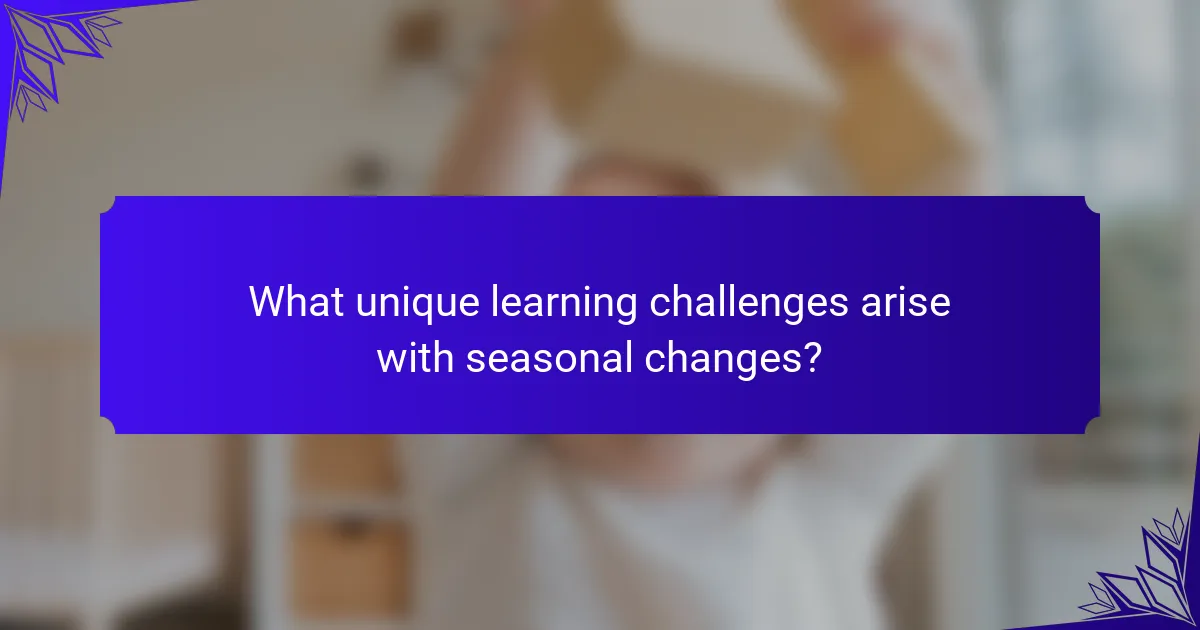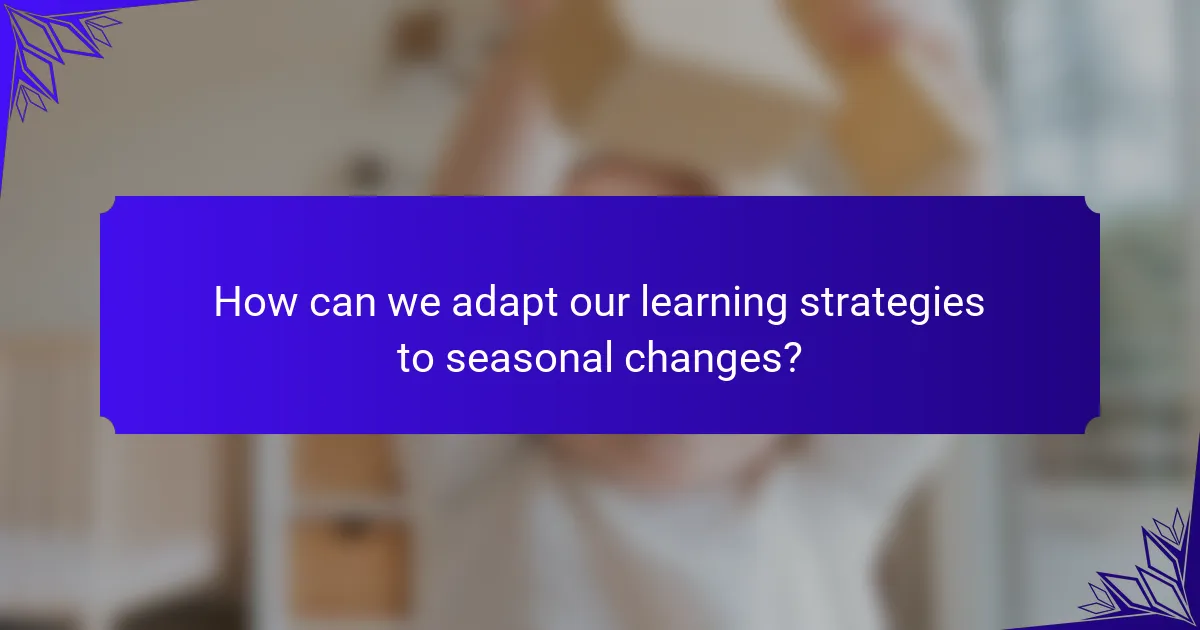Changing seasons affect our lifestyle, learning, and conditioning habits in various ways. They influence outdoor activities, dietary choices, and mental well-being. Seasonal shifts impact motivation and focus, posing unique learning challenges. Additionally, rare phenomena like solstices can alter physical activity and engagement levels. Understanding these effects helps individuals adapt their routines for improved health and productivity throughout the year.

How do changing seasons influence our lifestyle choices?
Changing seasons significantly influence our lifestyle choices, affecting activities, diet, and mental well-being. Seasonal changes prompt shifts in outdoor activities; for instance, warmer months encourage more physical exercise outdoors, while colder months often lead to indoor activities.
Dietary preferences also change with the seasons. During summer, people tend to consume more fruits and vegetables, while winter months may see a rise in comfort foods. This shift impacts nutritional intake and overall health.
Additionally, the seasons affect mental health. Seasonal Affective Disorder (SAD) is common in winter due to reduced sunlight, influencing mood and energy levels. Conversely, spring and summer often bring increased motivation and social engagement.
Understanding these seasonal impacts can help individuals adapt their habits for better health and well-being throughout the year.
What seasonal factors affect daily routines?
Seasonal factors significantly influence daily routines by altering mood, energy levels, and activities. For instance, longer daylight hours in summer encourage outdoor activities, while winter’s shorter days may lead to increased indoor time. Seasonal changes also affect learning habits; students often experience varying focus and motivation levels depending on the season. Additionally, weather conditions can dictate exercise routines, with many preferring outdoor workouts in pleasant weather and indoor alternatives during harsher conditions.
How do seasons impact physical activity levels?
Seasons significantly influence physical activity levels, with variations in weather and daylight affecting motivation and opportunities for exercise. For example, warmer months often encourage outdoor activities, while colder seasons may lead to reduced engagement in physical exercise. Research indicates that during spring and summer, people tend to be more active, averaging 30% more outdoor activities compared to fall and winter. Additionally, daylight duration impacts mood and energy levels, which are crucial for maintaining consistent fitness routines. As a result, awareness of seasonal changes can help individuals plan and adapt their physical activity strategies effectively.
What are the seasonal variations in outdoor activities?
Seasonal variations significantly influence outdoor activities by dictating what is feasible or enjoyable. In spring, people engage in gardening and hiking as temperatures rise. Summer promotes swimming and camping due to longer daylight hours. Autumn is ideal for apple picking and leaf-peeping, while winter encourages skiing and snowboarding. Each season shapes lifestyle choices and physical conditioning habits uniquely, catering to different preferences and environments.
How do indoor fitness habits change with the seasons?
Indoor fitness habits tend to shift with the seasons due to changes in weather, daylight, and motivation. In winter, people often prefer indoor workouts, while summer encourages outdoor activities. Seasonal affective disorder can decrease motivation in colder months, impacting fitness routines. Conversely, longer daylight hours in spring and summer boost energy levels, leading to increased physical activity. Adapting workout types and schedules to seasonal changes can enhance overall fitness and well-being.
What role do seasons play in mental well-being?
Changing seasons significantly impact mental well-being by influencing mood, energy levels, and social interactions. Seasonal changes can lead to variations in mental health conditions, such as Seasonal Affective Disorder (SAD), which affects individuals during specific seasons, particularly winter. Research indicates that exposure to natural light during spring and summer enhances mood and cognitive function. Additionally, seasonal activities, such as outdoor sports in warmer months, promote physical health, which is closely linked to mental well-being. Adapting routines and engaging with seasonal changes can improve overall psychological resilience and satisfaction.
How does seasonal affective disorder influence learning?
Seasonal affective disorder negatively impacts learning by reducing motivation and focus. During winter months, decreased sunlight can lead to fatigue and depression, hindering cognitive functions. Studies show that individuals with seasonal affective disorder often struggle with memory retention and information processing. As a result, educational performance may decline, emphasizing the importance of addressing mental health to improve learning outcomes.
What coping strategies can mitigate seasonal mood changes?
To mitigate seasonal mood changes, individuals can adopt several effective coping strategies. Regular physical activity boosts mood and reduces anxiety. Establishing a consistent sleep schedule helps regulate mood swings. Engaging in social activities provides emotional support and connection. Mindfulness practices, such as meditation, enhance emotional resilience. Lastly, exposure to natural light can alleviate symptoms of seasonal affective disorder.

What unique learning challenges arise with seasonal changes?
Seasonal changes create unique learning challenges, such as shifts in motivation and focus. For example, winter often leads to decreased daylight, affecting mood and energy levels, which can hinder learning. Additionally, summer vacations disrupt routine, making it difficult to maintain consistent study habits. These fluctuations can also influence memory retention and cognitive performance. Understanding these dynamics helps educators adapt teaching methods to support learners throughout the year.
How do seasons affect concentration and focus?
Changing seasons can significantly impact concentration and focus due to variations in daylight, temperature, and environmental factors. Longer daylight hours in spring and summer often enhance mood and energy, improving cognitive function. Conversely, shorter days in fall and winter may lead to decreased motivation and focus. Seasonal affective disorder, a unique attribute, affects many individuals during winter months, causing symptoms like fatigue and difficulty concentrating. Adapting routines to align with seasonal changes can help maintain focus, such as incorporating outdoor activities during sunny months and utilizing light therapy in darker seasons.
What are the impacts of seasonal distractions on education?
Seasonal distractions significantly impact education by influencing students’ focus and motivation. Changes in weather and daylight can lead to variations in academic performance and engagement levels. For instance, spring and summer often bring increased outdoor activities, which may distract students from their studies. Conversely, winter months can result in lower energy levels due to shorter days and colder temperatures, affecting attendance and participation. Research indicates that these seasonal variations can lead to fluctuations in grades, with students performing better in more favorable conditions.
How do weather conditions influence study habits?
Weather conditions significantly influence study habits by affecting motivation, concentration, and energy levels. Seasonal changes often lead to variations in mood and productivity. For instance, longer daylight hours in spring and summer can enhance focus and encourage outdoor study sessions. Conversely, winter’s shorter days and colder temperatures may lead to decreased motivation and increased distractions indoors. Research indicates that students may perform better academically during seasons that align with their personal preferences for weather. Adapting study environments to match seasonal conditions can optimize learning outcomes.
What are the effects of holiday seasons on academic performance?
Holiday seasons can negatively impact academic performance due to distractions and reduced study time. Students often experience a decline in focus and motivation as festivities take precedence. Research indicates that academic achievement may drop during these periods, particularly in subjects requiring consistent practice. As a result, maintaining a balanced routine during holidays is crucial for sustaining educational progress.

What rare seasonal phenomena influence conditioning habits?
Rare seasonal phenomena, such as the winter solstice and summer equinox, can significantly influence conditioning habits. These events impact mood and motivation, leading to variations in physical activity and learning engagement. For instance, longer daylight hours during summer encourage outdoor activities, while shorter days in winter may reduce motivation for exercise. Seasonal affective disorder (SAD) is a unique condition linked to these changes, affecting overall well-being and lifestyle choices. Understanding these phenomena can help individuals adapt their routines to align with seasonal shifts.
How do extreme weather events affect training routines?
Extreme weather events disrupt training routines by affecting outdoor conditions and indoor facility availability. For instance, heavy rain or snow limits outdoor activities, while extreme heat can lead to heat-related illnesses. Athletes may need to adapt their schedules and training methods, incorporating indoor workouts or adjusting intensity levels. Additionally, fluctuating temperatures can impact motivation and energy levels, influencing overall performance. These changes necessitate flexibility in training plans to maintain conditioning and progress.
What unique seasonal trends can enhance skill acquisition?
Unique seasonal trends can significantly enhance skill acquisition by aligning learning activities with natural cycles. For instance, spring often fosters motivation and renewal, making it an ideal time for starting new skills. Summer provides extended daylight, encouraging outdoor activities that enhance physical skills. Autumn often brings a focus on routine, which can solidify learning through structured practice. Winter, with its reflective nature, can be utilized for in-depth study and mastery of complex skills. These seasonal shifts create unique opportunities to adapt learning environments and methods, ultimately optimizing skill development.

How can we adapt our learning strategies to seasonal changes?
Adapting learning strategies to seasonal changes involves recognizing how different seasons influence mood, energy levels, and focus. For instance, winter may encourage indoor learning, while spring can boost motivation for outdoor activities.
In colder months, utilizing cozy environments and structured routines can enhance focus. Conversely, during warmer months, incorporating outdoor learning experiences can stimulate engagement.
Adjusting study schedules to align with daylight changes can also improve productivity. For example, utilizing natural light in spring and summer can enhance alertness, while evening study sessions in fall and winter may be more effective.
Overall, understanding these seasonal impacts allows for tailored learning approaches that maximize retention and motivation throughout the year.
What best practices can optimize learning throughout the year?
To optimize learning throughout the year, align study habits with seasonal changes. Adjusting routines based on seasonal attributes enhances retention and engagement.
In spring, leverage increased daylight by scheduling study sessions during peak energy hours. Summer allows for outdoor learning, integrating nature into educational activities. Autumn’s transition can inspire goal-setting, while winter provides quiet time for reflection and deep study.
Incorporating seasonal breaks can prevent burnout and maintain motivation. Adapting learning environments to reflect seasonal changes can also stimulate creativity and focus.
What common mistakes should be avoided during seasonal transitions?
To avoid common mistakes during seasonal transitions, focus on maintaining consistency in routines. Neglecting to adjust daily schedules can disrupt sleep patterns and productivity. Failing to adapt nutrition can lead to seasonal deficiencies, impacting overall health. Ignoring exercise modifications may result in decreased motivation and physical fitness. Lastly, overlooking mental health adjustments can increase stress and anxiety levels.
How can technology assist in adapting to seasonal learning challenges?
Technology can significantly help adapt to seasonal learning challenges by providing tailored resources and tools. Online platforms offer flexible learning schedules, enabling students to access materials anytime. Adaptive learning software personalizes educational experiences based on individual progress, making it easier to maintain engagement during seasonal shifts. Virtual reality can simulate seasonal environments, providing immersive experiences that enhance understanding and retention. Mobile applications facilitate learning on-the-go, ensuring that seasonal disruptions have minimal impact on educational continuity.


